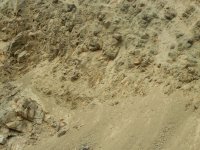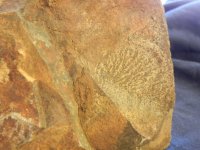Trapper John
Jr. Member
- Dec 29, 2014
- 85
- 136
- Detector(s) used
- Garrett AT Pro
- Primary Interest:
- Metal Detecting
After completing a trip to the John Day region of Central Oregon I have collected a few specimens that have me stumped. These will be "ho-hum" finds for most of you but I will share a few pics and my questions with your tolerance. Before I do so let me post a couple of things that I learned on my last trip.
1. A basic knowledge of rock formations is a must. It helps to be able to describe the landscape in terms that geologists and rockhounds can relate to. The ability to distinguish between igneous, sedimentary, and metamorphic rocks is a "must" but it also helps to know the major flows and formations that have occurred over time.
2. Rock and mineral identification is "easy" with guide books and colored plates. Field identification is quite another issue. Those who have some degree of color-blindness may need help as well. Also it never hurts to admit ignorance and ask someone who knows.
3. Basic tests such as hardness and color streak help to manage the mysteries, but there is no substitute for "hands on" experience. Going without tools for these tests is a little like going fishing without bait. It limits your probability of success, and makes it hard to explain to others what you found. I must improve my tool kit!
4. Road cuts are a great place to investigate. Let nature and gravity do the work for you - even if "choice" specimens are farther up the surface material.
On the third point, I need to reinforce a few basic "common sense" rules. First, be especially careful about where you dig. Some states (like Oregon) specifically prohibit removing material from the cut itself, so as to reduce the probability of collapse and highway littering. Fallen stuff is okay, but by all means remember what the road is there for, and it ain't people afoot!
That said, my best "finds" were calcite crystals in matrix - which I think was limestone. I have attached a few pics and do not plan on doing anything to them without advice - which is eagerly sought and gladly accepted. The crystals themselves are dendritic but I have no idea what mineral has created the dendrites on the crystal. I have no pics of this but have found similar patterns on another rock which I will photograph later.
Any comments will be greatly appreciated!

1. A basic knowledge of rock formations is a must. It helps to be able to describe the landscape in terms that geologists and rockhounds can relate to. The ability to distinguish between igneous, sedimentary, and metamorphic rocks is a "must" but it also helps to know the major flows and formations that have occurred over time.
2. Rock and mineral identification is "easy" with guide books and colored plates. Field identification is quite another issue. Those who have some degree of color-blindness may need help as well. Also it never hurts to admit ignorance and ask someone who knows.
3. Basic tests such as hardness and color streak help to manage the mysteries, but there is no substitute for "hands on" experience. Going without tools for these tests is a little like going fishing without bait. It limits your probability of success, and makes it hard to explain to others what you found. I must improve my tool kit!
4. Road cuts are a great place to investigate. Let nature and gravity do the work for you - even if "choice" specimens are farther up the surface material.
On the third point, I need to reinforce a few basic "common sense" rules. First, be especially careful about where you dig. Some states (like Oregon) specifically prohibit removing material from the cut itself, so as to reduce the probability of collapse and highway littering. Fallen stuff is okay, but by all means remember what the road is there for, and it ain't people afoot!
That said, my best "finds" were calcite crystals in matrix - which I think was limestone. I have attached a few pics and do not plan on doing anything to them without advice - which is eagerly sought and gladly accepted. The crystals themselves are dendritic but I have no idea what mineral has created the dendrites on the crystal. I have no pics of this but have found similar patterns on another rock which I will photograph later.
Any comments will be greatly appreciated!








